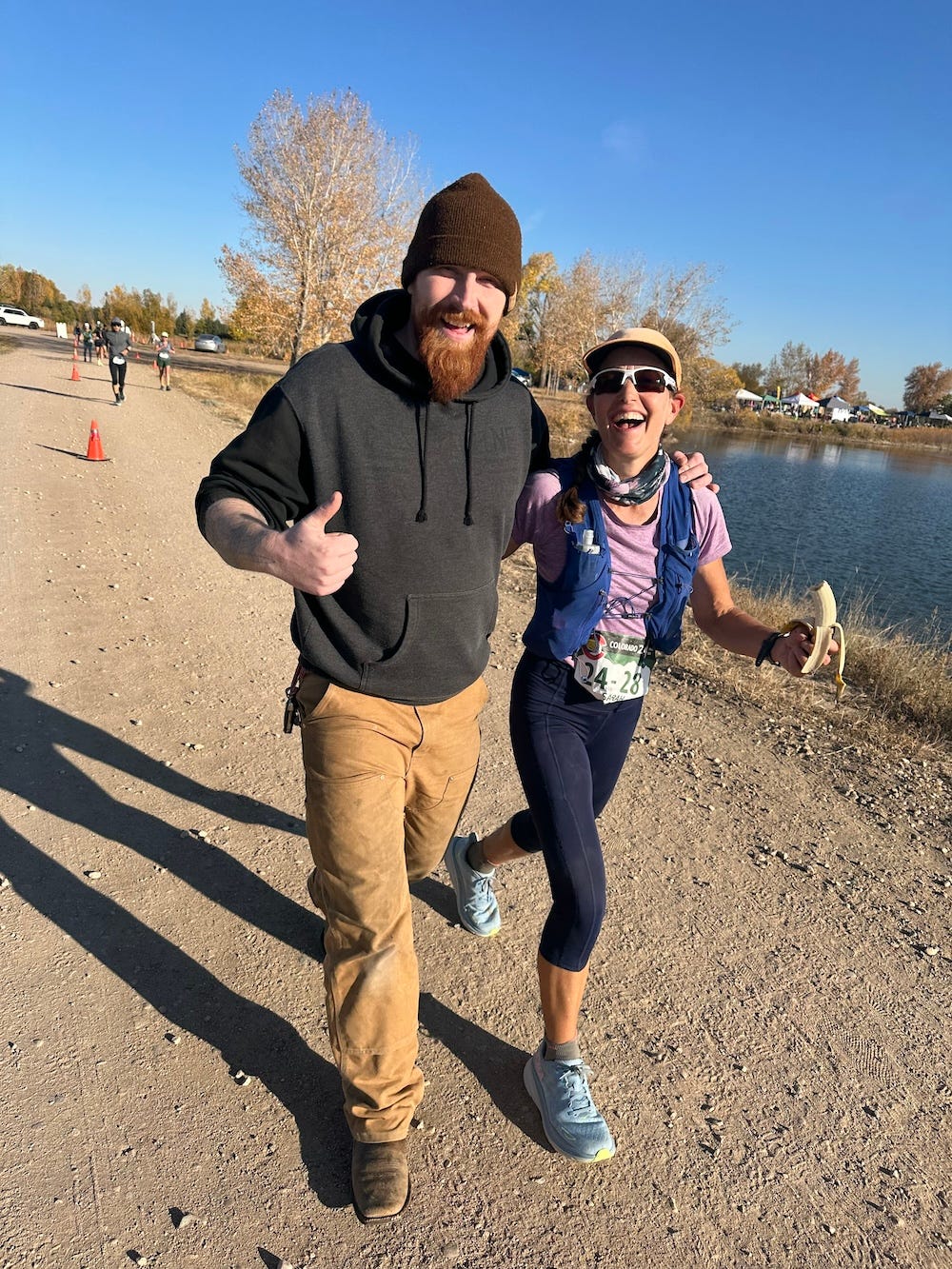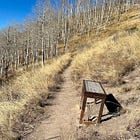Hello on this special Tuesday fraught with anticipation over election results. I’m posting this story today, rather than Wednesday, because I figure most people will focus on election news tomorrow. I hope this post might inspire you to engage in self-care and goal-setting, or simply get outside to walk or run in a meditative way.
Endurance athletes generally view quitting as synonymous with failure, even though in real life it can be a positive action, like quitting a bad job for a better opportunity. I have a story this week about the rare times when quitting an ultramarathon is the right move.
Generally, I don’t drop out of ultras. I mentally remove quitting as an option and believe that finishing is non-negotiable. I tell myself that “DNF” means “Do Nothing Fatal,” as in, your DNF (“Did Not Finish”) is justified only if your life is on the line. When it comes to ultras, you could say I’m hard-ass, even though in other life pursuits I’m half-ass.
Yet Saturday night, I dropped out of an ultra at 62 miles (100K) instead of the intended 100 miles. I did it because I followed my own advice, articulated in my book under a section headlined, “Know When to Tough It Out and When to Quit.”
I’d like to share that advice, but first I’ll set the scene, which involves an inaugural event I’d highly recommend in Fort Collins, Colorado.
Five weeks ago, I finished the Grand to Grand Ultra 170-mile self-supported stage race (recap here), which was my big running goal for the year. For nine months (like gestation), all my training and shorter-distance ultras were in service of this big, special goal. I finished it September 28, rested and recovered with minimal training for a few weeks, then felt fresh and injury-free running again.
Meanwhile, earlier in the year, I registered for a new event called the Colorado 24 Hour Run put on by the good guys behind the group Gnar Runners, Nick Clark and Brad Bishop, held last weekend. I was on the fence about it because it wasn’t an “A” goal for me—it was more of an afterthought to the Grand to Grand Ultra—and I wasn’t willing to tough out stormy weather. I’d go only if the forecast called for a clear sky and manageable temperatures.
When I realized last week that the weather would cooperate, I decided to go for it. What’s the worst that could happen? It’s a low-stakes and logistically easy ultra. I packed up everything I’d need to crew myself for 24 hours (special snacks and drink mix, layers of clothing and headlamp, folding chair, even an old yoga mat and sleeping mat in case I needed to get horizontal and warm up), and I made the seven-hour drive north.
The event is a timed ultra, with 6, 12, and 24-hour divisions, meaning you run as much as you can or want in that time window, and you moderate your pace and your breaks to achieve that goal.
You could, for example, sign up for the 24-hour division and choose to complete only a 26-mile marathon in that time, slightly more than one mile per hour. Or, you could aim to go 168 miles (an average pace of 8:34/mile, with breaks for eating, bathroom stops, and any rest averaged in) and beat Camille Herron’s 24-Hour World Record of 167.8 miles. It’s entirely up to you how far you go in the time period.
The route was a flat one-mile loop on a hard-packed dirt and gravel road. The event therefore was an opportunity for pure, steady running without the variables of hills and technical terrain.
The appeal of a repeat-loop timed ultra
The idea of repeating the same mile over and over again may strike you as the ultra version of purgatory, but it appeals to me for several reasons. One, as mentioned above, it allows for smooth, flat running so you can test yourself as a runner without hills, rocks, and all the other factors that affect the pace of trail running.
When I recently did the self-supported Grand to Grand Ultra across the Arizona-Utah desert, I was slowed down by the weight of my pack (about 20 pounds), the intense heat of the day, the elevation profile that included steep, rocky hills with dense vegetation, and the deep, soft sand. After so much sand-slogging, I wanted to challenge myself to run in a flowing, unobstructed way with minimal walking breaks.
Also, it’s social. You’re surrounded (but not crowded) by people engaged in the same personal challenge, which makes for interesting people-watching and friendly conversations. I got to study and know individuals by their stride, clothing, and mannerisms. Some—including several elderly participants, one of whom used a trekking pole to prop up her leaning body—walked the whole time. Others ran with a beautiful strong, faster stride.
The gathering felt both diverse and egalitarian. Everyone was doing their own thing. I could settle into a pace that felt right for me and feel supported by all those around me.
I also love how running laps can become an exercise in mindful meditation if you challenge yourself to be highly observant and study a place in detail, and to see that place change over the course of a day based on the position of the sun. I made a point of noticing different details on every single lap. The one-mile route, thankfully, covered a scenic area surrounded by bodies of water. It’s part of the Colorado Youth Outdoors campus, devoted to outdoor recreation. I focused my eyes on the way the water shimmered, on the mini islands that stood in the center of the ponds, on the different types of grasses sprouting, and on the scene of vehicles passing on the highway nearby.
My Strava map of the activity illustrates all the water surrounding the course:


My plan and goal
To succeed at a timed-loop ultra, you need a plan and a goal. If you just “run by feel,” then pretty soon you’ll feel it’s pointless and tiring, and you’ll decide to drop.
I have done a similar 24-hour ultra with a one-mile flat lap twice before, in 2015 and 2017. Both took place on a rectangular route at Crissy Field on the San Francisco waterfront. Both times, I had a goal of getting to 120 miles. (Easy math: that’s 5mph or a 12 min/mile average pace, which sounds slow but is actually pretty ambitious when you factor in the rest stops for bathroom breaks, eating, and changing into nighttime clothes.) Both times, my ankles blew up with inflammation, likely caused by pivoting around the right-angle turns on that route’s rectangular shape. In both those 24-hour attempts, I resorted to painful walking in the final hours and got to 115 miles.
This time, I decided on a completely different strategy, and the curiosity of seeing how that strategy would play out kept me motivated.
I was intrigued by the Backyard Ultra format (explained fully in this post) in which runners repeat a 4.167-mile lap at any pace they want. They just have to finish the lap and start the next one at the top of the hour to stay in the last-person-standing contest. So basically they’re doing slightly more than 4 miles in an hour, and taking a break at the top of the hour.
My goal this time was to go “only” 100 miles in 24 hours, and my plan was to mimic the backyard format by taking a substantial walking/bathroom/eating/stretching rest break near the top of each hour, lasting five to ten minutes. I figured this was much more sustainable than my earlier 24-hour attempts, when I ran more continuously in pursuit of 120 miles and didn’t have a clear plan for taking breaks.
It worked great! Until it didn’t.
Calling it quits
I settled into an easy, sustainable pace. That’s another thing I like about this format: I don’t push myself to run a stressful high-intensity pace, as in a road marathon where I’m trying to Boston-qualify. On the contrary, the point is to find a “forever” pace that could last all day and night. Early in the day, that comfortable pace was around 10:30/mile. I knew that at night, due to darkness and fatigue, I’d slow down to a 13ish min/mile pace with more walking breaks, but that was fine. I just needed to average better than 14:20ish per mile to get to 100 miles in 24 hours.
Dare I say it was fun? I felt really good. For several hours, an audiobook entertained my brain while my eyes took in the sights. I generally do not recommend audiobooks or podcasts for racing, because they can make you space out and slow down, but for this format, it worked well. (I chose a book with an easy-to-follow plot and engaging characters, Liane Moriarty’s latest novel, Here One Moment. Liane Moriarty is always a safe choice for a fun, easy read! This is the fifth novel I’ve read by her.)
Each hour, I’d run a steady-Eddy pace for about 50 minutes. Then I’d take 10 to walk, stretch, and eat. And I enjoyed eating! My stomach didn’t shut down, as it often does mid-ultra, because I wasn’t stressed by exertion or heat. These top-of-the-hour breaks allowed me to eat as I should—mostly a mix of bars, salty ramen noodles, and chunks of cooked sweet potato that I brought, and the aid station’s quesadilla triangles. I got simple sugar and electrolytes from the drink mix that I steadily sipped (I alternated between lower-calorie Scratch and higher-calorie Tailwind).
At one point, my nephew Tyler who lives in the area showed up and shared a 10-minute break with me, which boosted my spirits further:
I got into a groove with this pattern. Knowing that I’d have a break at the top of the hour helped me run steadily for the 50ish minutes leading up to it.
About 9.5 hours into the day, I hit 50 miles and thought, “Wow, that was a really good-feeling 50. Who would’ve thought?” I also realized I had banked a lot of time and could take extra walking breaks and slow my pace for the second half and hit 100 miles in 24 hours, no prob. Then I began to flirt with the idea of scoring a new 100-mile PR, besting my 100-mile personal best of 21:43 set in 2014.
My fantasy—no, my plan—became to hit the 100-mile mark around 21 hours. Then I’d take a big break with a big dinner and finish out the 24 hours walking with others, enjoying simply walking and supporting others through the dark, cold hours as the clock ran out.
If only.
Two miles later, I felt an unpleasant zing on the side of my left knee. I said “ow” out loud. One minute I was running fine, the next minute I wasn’t. My f’ing IT band was angry.
I have two problems with my left knee. One involves thinning cartilage under the patella. It’s like a worn-out brake pad. But it has felt good ever since I got a hyaluronic acid injection in it, which lubes the joint. My kneecap hadn’t bugged me all day. The other problem involves the iliotibial (IT) band of tissue that runs on the outside of the thigh from hip to knee. Mine has hurt off and on over the past year where the bottom of the IT band inserts at the head of the tibia. I’ve done physical therapy and had a cortisone shot to manage it. It behaved well enough during the Grand to Grand Ultra and was quiet this past month, so much so that I forgot about it being an issue. Then around mile 52, it flared up big time.
I changed into my nighttime layers and headlamp as the sun went down, and I resolved to go another 10 miles and assess the situation then. I took a selfie and posted it to my Instagram story. “Getting dark and cold, getting interesting,” I captioned it.
I tried to run. The more I ran, the more I felt sharp pain in that one spot on the outside of my left knee. I tried to change my stride in a way that would relieve it. After a few miles, the only way that “running” felt manageable was limping—favoring my left leg and making my right leg do most of the work.
It was around that time, in the mid-50s of mileage, when I reflected on my checklist of questions to determine whether to tough it out or to quit.
Are you risking life or limb, and might you need hospitalization? No, it’s not that bad.
Is it a problem significantly affecting your ability to bear weight on a foot and run symmetrically (which can cause a secondary injury), and does it worsen when you continue? Yes and yes, unfortunately.
Have you been unable to digest any calories or fluids for several hours, and do you face many more hours until the finish line? No, that’s not the problem.
Are you in the midst of a less-important race leading up to your “A”-goal race and experiencing problems that could affect your ability to participate in the race you care more about? Yes, sort of.
When I analyzed the circumstances and weighed the tradeoffs, I realized this event didn’t really matter—it wasn’t a long-sought goal, such as the Hardrock 100, where I’d choose to suffer through limping and puking for hours and end up injured for months for the sake of a finish. Doing this event was entirely optional. And I didn’t want to feel injured afterward. I want to be able to enjoy running and skiing this winter, and train for a March marathon.
But I’m stubborn. If I couldn’t make it to 100M, I wanted to make it to 100K (62 miles). Why? Because it’s 100K.
So I walked/jogged/limped to 62 miles, and at 12 hours, 38 minutes (8:38 p.m. at night), I told the RD I needed to quit.
It was an easy decision, really, and I don’t regret it. But I do regret toughing out those final pointless miles. In hindsight, I should’ve dropped as soon as I realized the pain was getting worse and not going away.
By going those extra miles, I did more damage. Now, three days later, I’m still in pain going up and down stairs, and I’ll likely have to take a few weeks off from running and do a great deal of PT until I feel normal again. I’m mad at myself about that.
The day following the event, I was shocked to see visual evidence of the damage I caused. The painful point was discolored, as if bruised. But I hadn’t banged it externally. It was discolored from internal stress and perhaps a bit of bleeding. That’s how bad it hurt, and how much stress I caused. Not smart!
So now I’m resting and recovering. I hope my cautionary tale of a bad outcome helps you make the best choice if ever you find yourself debating whether to tough out an injury or illness. Sometimes, I believe it’s justified and reasonable, if the competition or finish really matter to you. This wasn’t one of those times for me.
But I don’t regret participating in this event. I relished it for 50 miles. Check out their website if you’re interested in next year’s edition.
Have you ever made the right decision to quit a race, or have you dropped and regretted it? Share your DNF stories below!
Related post:
If you’d like to support my writing but would rather not subscribe at the paid level, perhaps consider making a small donation in the virtual tip jar below. Thank you!









I DNF’d the Leadville 100 one year at mile 95 with time still on the clock to finish… my justification was that I already had one of their belt buckles… and I didn’t need that extra jewelry that they give the women that finish… And what if I end up with that ‘Last Ass” trophy that’s half of a donkey that they give to the last person that finishes by the 30hr cut off. I was having such a solid race until around mile 80 and things started to slow down significantly… I just was done. I think my husband was more disappointed about my insistence that I just didn’t want to continue … and I have to say I would get a little emotional over the next few years every time we passed the place it happened on our way to camp at Turquoise Lake. But now I look back and laugh!! ! It’s all part of the adventure… That’s what ultras are about. The Subaru that pulled over and drove me into town was driven by a guy named “Rainbow”! No regrets!
Dang, Sarah! I think you should consult with a doctor. The sudden snap and the bruising both suggest this could be something more than just a flared up IT band. How frustrating for you, when everything had been going so well too! But seriously, that looks ugly enough to get checked out. When I was googling about my hamstring suddenly going “snap” like that, I found out that it (plus bruising) was an indicator of a torn tendon. I hope I’m wrong, but something like that might have happened.